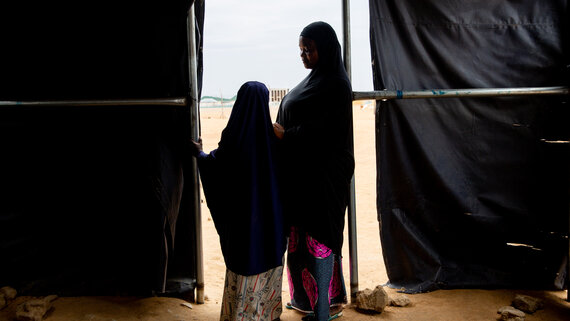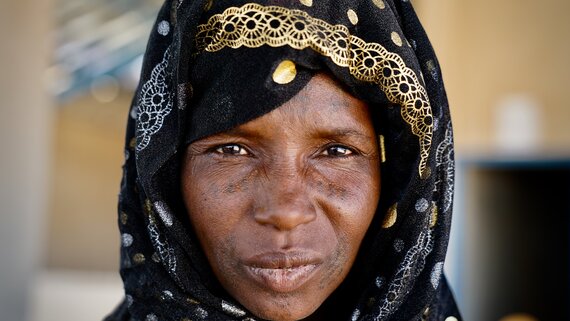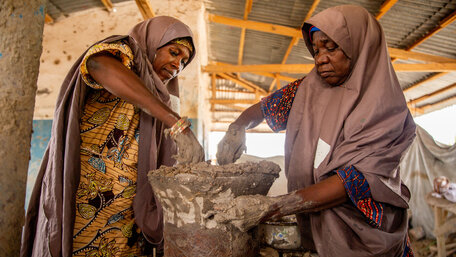Maiduguri, Nigeria
A displaced family from north-east Nigeria currently living in Bakassi camp. OCHA/Damilola Onafuwa
Women and girls have greater representation in humanitarian prioritization and response, but more women are needed in leadership roles, and underfunding for GBV mitigation and prevention remains of critical concern.
The enhanced HPC approach has helped to better represent gender, age and disabilities in humanitarian prioritization and response, through the improved collection of disaggregated data.
In 2021, 100 per cent of HNOs reflected analysis of the humanitarian impacts on women and girls and 89 per cent of HNOs reflected GBV risks and impacts, a great improvement from the previous year. Regional- and country-level gender working groups and networks are producing analysis and working to increase the participation of women-led organizations in humanitarian decision-making and programming in Afghanistan, Cameroon, CAR, Chad, Jordan, Myanmar, Nigeria, oPt, Philippines, Somalia, Syria, Ukraine, Yemen and the MENA and Asia-Pacific regions.
Despite this, stronger gender analysis is needed to further place the spotlight on women and girls, particularly those with multiple needs including adolescent girls, young women, and women and girls with disabilities.
The first-ever thematic evaluation on women and girls in emergencies

The Inter-Agency Humanitarian Evaluation (IAHE) on Gender Equality and the Empowerment of Women and Girls (GEEWG) has assessed progress on the operationalization of its agenda since 2017. The IAHE also captures best practices and provides recommendations to further mainstream GEEWG into humanitarian action. The evaluation highlights areas including gender equality in humanitarian action, the meaningful participation of women and girls in humanitarian decision-making, and technical gender expertise in onset and protracted crises. The evaluation also looked at gender capacities at cluster and HCT levels, funding for programming and coordination, and accountability for mainstreaming GEEWG at country and global levels. Recommendations are being implemented, with progress integrated and tracked using the IASC Gender Accountability Framework.
OCHA/Damilola OnafuwaWomen-led organizations
The first system wide Inter-Agency Humanitarian Evaluation on Gender Equality and the Empowerment of Women and Girls called for greater efforts to address the gap in the representation of women-led organizations in humanitarian decision making. Despite noting progress since 2017, including an uptick in consultations with women, the evaluation concluded that they were still not sufficiently represented.
The ERC has called for the inclusion of women-led CSOs in HCTs to ensure their engagement in humanitarian decision-making processes. The IASC also produced new guidance on ‘Strengthening participation, representation and leadership of local and national actors in IASC humanitarian coordination mechanisms’. Enhanced efforts from partners have resulted in increased engagement of local women-led organizations and their meaningful participation in HPC design and planning as well as HCTs - particularly in Ethiopia, Iraq, Yemen, Myanmar, and Syria.
Women leaders push for positive policy changes in cross-border humanitarian response
Female teachers in north-west Syria often earn low salaries — on average the equivalent of $150 per month. Many work long hours and are the sole breadwinners for their families. Without these teachers, many children in north-west Syria would not receive an education. In 2000, six female elementary school principals from Idlib, Syria, led an initiative to lobby local authorities and NGOs for better working conditions. They filmed a video showing the plight of teachers in Idlib, which reached a wide international audience and caught the attention of high-level officials.
The women inspired a group of female Syrian humanitarian workers, who joined forces with them to further amplify advocacy efforts. This led to a change in human resources policy, including granting maternity leave and improving working conditions for around 5,000 women across north-west Syria. The group then expanded its scope of work. It began advocating for a more gender-sensitive approach to programming and a stronger focus on girls and women in the needs assessment and planning stages of humanitarian responses, as well as stronger representation of women in humanitarian decision-making forums. The Women's Advisory Board for the Humanitarian Liaison Group (the HCT for the cross-border humanitarian response) was created in 2021, comprising of 20 women based in north-west Syria and south-east Turkey. They each hold senior positions with humanitarian organizations operating in Syria, striving to accomplish positive policy and strategic changes in the cross-border humanitarian response.
In the video: A lack of maternity leave, childcare and long working hours for very low salaries makes life extremely hard for these female teachers in northwest Syria. Despite this they are committed to providing an education for children who are displaced by conflict and are campaigning for a change in their working conditions.
Hurras NewtworkFunding shortfalls
Lack of funding for the response to and the mitigation and prevention of GBV remains of critical concern. The IASC continues to advocate for funding and scrutinize and remove the impediments to GBV response, including societal/cultural stigma, lack of survivor-centred approach, and limited meaningful engagement of women-led organizations and women affected by conflict in humanitarian design. However, funding for GBV has only reached above 20 per cent of the global requirements, severely limiting the capacity to save lives and meet the needs of GBV survivors in humanitarian contexts.
To follow through on the humanitarian system’s commitments to combat GBV and the chronic issue of underfunding, a High-Level Round Table led by the ERC with IASC Principals and donors was convened. This resulted in improved visibility and tracking of GBV funding, including through the new Financial Tracking Service (FTS) page, which provides comprehensive information on system-wide funding allocations for GBV programming. The FTS page presents the funding requirements for GBV mitigation, prevention and response, providing a comprehensive overview of the global sector requirements for all HRPs and appeals in the GHO. More features will be added to the page shortly which will make it easier to download data for enhanced analysis.
IASC Gender Standby Capacity Project

GenCap continues to be an important gender mainstreaming resource for Humanitarian Country Teams (HTC). In 2021, it provided strategic and operational support to 18 country-level contexts, all of which had inter-agency coordinated appeals. GenCap senior advisers supported humanitarian operations in Afghanistan, Burkina Faso, Cameroon, CAR, Chad, DRC, northern Ethiopia, Haiti, Honduras, Mali, Mozambique, Niger, Nigeria, Somalia, South Sudan, Syria Cross-Border Response (Turkey), Yemen and Zimbabwe.
In Mali, GenCap supports the HCT to implement the IASC policies on gender-equality and the empowerment of women and girls in humanitarian action. GenCap consulted more than 40 key informants to establish baselines, collective priorities and targets for the HCT to produce a road map on gender equality programming in emergencies (GEPiE). Stakeholders included humanitarian leadership, clusters, technical experts, CSOs, local and international NGOs, UN agencies, donors and Governments. GenCap also supports the localization of humanitarian response through reinforcing local capacities. The Mali GEPiE road map is being implemented, with several NGOs leading or co-leading areas and activities. GenCap will continue providing support to enhance outcomes, as well as the monitoring and evaluation of the interventions and their impact.
The Central Emergency Response Fund (CERF) has increased pooled funding for GBV response through its Underfunded Emergencies window and a CERF allocation to UNFPA and UN Women. CERF’s Underfunded Emergencies window allocation of $100 million for 10 countries earmarked $9.6 million for GBV priorities and included $30 million allocated to Yemen to exclusively address issues for women and girls, including public health. The total amount allocated by country operations to GBV-related programming increased from an earmarked $9.6 million to $21.7 million, including indirect GBV outcomes under the health sector. CERF funding of $25 million was allocated to UN Women and UNFPA to address GBV across 11 countries affected by humanitarian emergencies and to support 770,000 affected people. An estimated 40 per cent of that funding – $10 million – has been allocated to women-led organizations and women’s rights organizations in 2021-2022. Going forward, CERF has committed to ensuring 30 per cent of funding to local women’s organizations for projects related to GBV.
CBPFs have achieved considerable results in gender equality and GBV. In 2020, the CBPFs allocated $863 million in total, all of which required the use of the IASC Gender with Age Marker (GAM) to ensure gender equality was a key consideration. Using the GAM, 66 per cent of funding aimed to contribute to gender equality. In 2020, 38 local women-led organizations were eligible to receive funding in 18 CBPFs (9 per cent of all partners). GBV was the main objective of 9 per cent of CERF-funded projects in 2020, with 62 per cent including a GBV component. CBPF is currently reviewing the global guidelines to better encourage and improve access for local women-led organizations to CBPFs and to promote the participation of women-led/women’s rights organizations in governance arrangements, including advisory boards and project review committees.
Further reading
Source: Financial Tracking Service
Source: IASC
References
- Annual Humanitarian Programme Cycle Quality Scoring exercise undertaken by OCHA, UK FDCO, USAID, ECHO, UNICEF, WHO, IOM, UNFPA, and UNHCR.
- Analysis of Gender-Based Violence in 2021 Humanitarian Needs Overviews and Humanitarian Response Plans, GBV AOR, June 2021.





